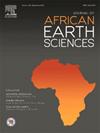喀麦隆东部ngura - colomines剪切带区域和局部构造对金矿化的控制:对剪切带金矿找矿的启示
IF 2.2
4区 地球科学
Q2 GEOSCIENCES, MULTIDISCIPLINARY
引用次数: 0
摘要
在喀麦隆东部的泛非-北赤道褶皱带内发现了几个金矿。然而,揭示变形历史、构造环境和金矿化之间复杂的相互作用还需要进一步的研究。以这些方面为重点的合作研究工作是释放该地区金矿资源全部潜力的关键,至少从相对较浅的层面(几公里)到深层地壳层面(几十公里)。本文对位于博登地区的恩古拉-科洛明韧性-脆性剪切带进行了结构分析。该区由矿化的S-C花岗岩柱体及其相关矿脉组成,这些矿脉被置入片麻岩中。新的U-Pb锆石年代测定将侵入事件推定为630Ma。卫星、实地和岩石学研究揭示了四个主要变形事件的证据:(1) D1 记录了 NNW-SSE 延展性缩短,变质岩中存在压缩结构;(2) D2 记录了一个以延展性剪切变形为主的较长时期,分为金矿化前、同步和后三个子事件;(3) D3 记录了韧性向脆性的过渡,与韧性的 D2 结构重叠;以及 (4) D4 是一个脆性事件,主要特征是断裂、辉绿岩堤和矿化石英脉,主要走向为 NNE-SSW 至 ENE-WSW。恩古拉-科洛明斯地区的构造历史与从地壳中层到地壳上层的漫长的泛非剪切变形历史相一致。金的成因与两个特定的变形阶段有关:在D2阶段中期的韧性剪切变形过程中形成了散粒金,而在最后的D4脆性变形过程中形成了块状金。本文章由计算机程序翻译,如有差异,请以英文原文为准。

Regional and local structural controls on gold mineralization in the Ngoura-Colomines shear zone, Eastern Cameroon: Implications for gold exploration in shear systems
Several gold occurences have been identified in eastern Cameroon, within the Pan-African-North Equatorial Fold Belt. However, unraveling the complex interplay between deformation history, tectonic setting, and gold mineralization demands further investigation. Collaborative research efforts focused on these aspects are key to unlocking the full potential of this region's gold resources at least from relatively shallow levels (a few kilometers) to deep crustal levels (tens of kilometers). This paper presents a structural analysis of the Ngoura-Colomines ductile-to-brittle shear zone, located within the Boden District. The zone comprises mineralized S-C granitoid plutons and their associated veins emplaced into gneisses. New U-Pb zircon dating constrain the intrusive event to ∼630 Ma. Satellite, field, and petrographic studies reveal evidence of four main deformation events: (1) D1 records NNW-SSE ductile shortening with compressional structures in the metamorphic country rocks; (2) D2 records an extended period of dominantly ductile shear deformation divided into pre-, syn- and post-gold mineralization sub-events; (3) D3 records a ductile-to-brittle transition that is superposed on the ductile D2 structures; and (4) D4 is a brittle event mainly marked by fractures, aplitic dykes and mineralized quartz veins mostly trending NNE–SSW to ENE–WSW. The tectonic history of the Ngoura-Colomines area is consistent with a protracted history of mostly shear-related Pan-African deformation continuing from mid-crustal to upper crustal levels. Gold genesis is linked to two particular stages of deformation: disseminated gold was formed during ductile shear deformation in the middle of the D2 stage and lode gold developed during the final D4 brittle event.
求助全文
通过发布文献求助,成功后即可免费获取论文全文。
去求助
来源期刊

Journal of African Earth Sciences
地学-地球科学综合
CiteScore
4.70
自引率
4.30%
发文量
240
审稿时长
12 months
期刊介绍:
The Journal of African Earth Sciences sees itself as the prime geological journal for all aspects of the Earth Sciences about the African plate. Papers dealing with peripheral areas are welcome if they demonstrate a tight link with Africa.
The Journal publishes high quality, peer-reviewed scientific papers. It is devoted primarily to research papers but short communications relating to new developments of broad interest, reviews and book reviews will also be considered. Papers must have international appeal and should present work of more regional than local significance and dealing with well identified and justified scientific questions. Specialised technical papers, analytical or exploration reports must be avoided. Papers on applied geology should preferably be linked to such core disciplines and must be addressed to a more general geoscientific audience.
 求助内容:
求助内容: 应助结果提醒方式:
应助结果提醒方式:


